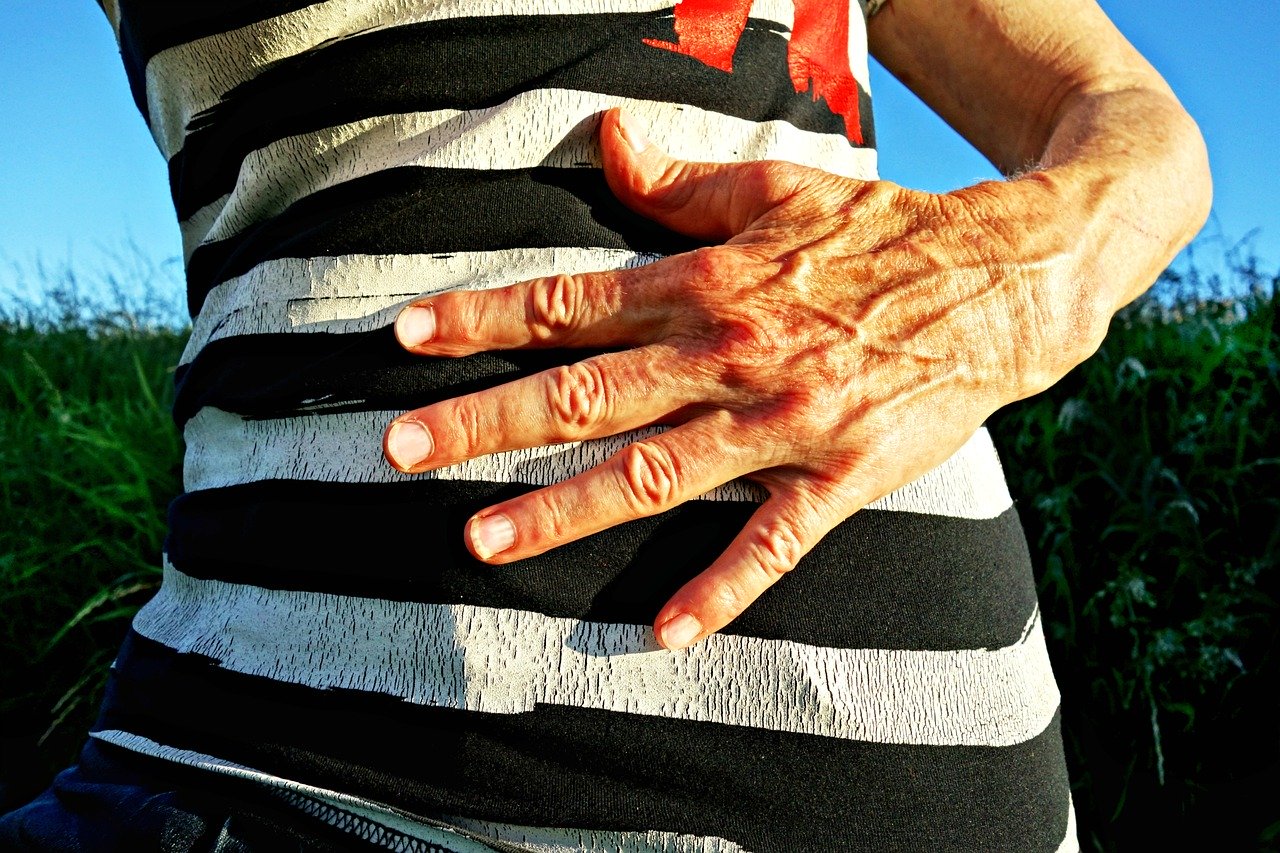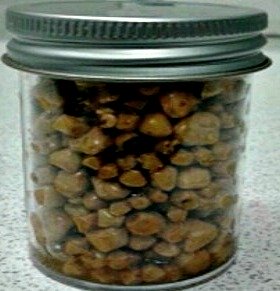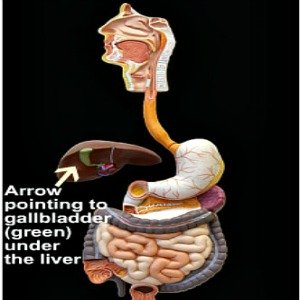Biliary Colic
Right Upper Abdominal Pain Caused By Gall Bladder Stone Impaction
Biliary colic is the blockage of the bile duct by gallstones. When the bile duct is blocked, the duct goes into painful spasms to expel the stone.

What is the Gallbladder?
The gallbladder is a pear-shaped sac lying just under the right half of the liver. It is where bile - the green bitter liquid we find in our vomit - is stored. It has a narrow part that joins the liver ducts and the pancreas before they continue as a single drainage duct into the small intestine.
The liver produces about 500 to 1500mLs of bile every day. Some of this amount drains directly into the small intestines where it helps to emulsify or break down fat in our meals into water soluble material for easy digestion.
The remainder amount of bile is stored away in the gallbladder. The gallbladder concentrates the bile about ten times stronger than its original composition. If the bile gets over concentrated, crystals start to form in the solution, leading to stone formation.
This stone is what is referred to as gall stone.
Gall stones could be anything from the size of grains of sands up to tennis ball size. They could be only a few in some people to several hundreds lodged inside the gallbladder.
We have included a picture to the right of this paragraph, of a bottle filled with gallstones from one patient. He has been suffering with pain on his right upper abdomen for many months before a scan result identified his pain to be due to biliary colic or gallstones.
There are three types of gallstones. The type of gallstones you form will depend a lot on your diet. The three types of stones are:
In the United Kingdom and other affluent industrialized western countries, cholesterol stones are most prevalent. This is mainly because of high fat diet. In poor countries, pigment stones are more common.
Cholesterol stones, as the name suggests, contains cholesterol mainly. Pigment stones contain bilirubin salts (e.g. Calcium bilirubinate).
Up to 15 out of every 100 persons form stones in their gallbladder, and most times, these stones do not cause any problem. In the United States, over 20 million people have gallstones. 80 – 90 % of these are cholesterol stones. This situation is similar in other western countries. One in five women and one in eight men have gallbladder stones.
Who is at Risk for Gallstones?
The gallbladder is a pear shaped sac lying just under the right half of the liver.
It is where bile, that green bitter liquid we find in our vomit, is stored. It has a narrow part that joins the liver ducts and those of the pancreas, before they continue as a single drainage duct into the small intestine.
The liver produces about 500 to 1500mLs of bile every day. Some of this amount drains directly into the small intestines where it helps to emulsify or break down fat in our meals into water soluble material for easy digestion.
The remainder amount of bile is stored away in the gallbladder. The gallbladder concentrates the bile about ten times stronger than it was originally. If the bile gets over concentrated, crystals start to form in the solution, leading to stone formation.
This stone is what is referred to as gall stone.
Women are twice as likely to develop gallstones than men. If you eat foods that rich in fats like meats and dairy products, you are more likely to have gallstones.
The following are other risk factors for developing gallstones. They include:
- Middle-aged females of Northern European descent who are carrying extra weight
- Being of Pima Indian, North American and Chilean descent.
- Obesity or over-abundance of cholesterol in the bile
- Taking birth control pills, hormone replacement therapy for menopause
- Rapid weight loss or prolonged fasting
- Pregnancy
- Family history of gallstones
- Having diseases such as Crohn’s, diabetes, cystic fibrosis, liver cirrhosis, sickle cell anaemia
Gallbladder Diseases
Biliary colic or gallstone pain, gallstone sludge, cholecystitis, gallstone pancreatitis and gallstone ileus, are all a continuum in the spectrum of conditions referred to as gallstone or gall bladder diseases. Understanding how they relate helps you to understand the possible problems and complications that could arise from having gallstones.
Silent Stones
Most gallstones in the gallbladder do not cause any problem. It is estimated that up to 80% of people who carry stones in their gallbladder have no symptoms, no pain, and no knowledge of their condition. Such stones are referred to as silent stones. They may be accidentally picked up by ultrasound scan during investigation of the abdomen for other reasons. If they don’t cause any health problems, silent stones are better left alone.
Biliary Colic
When stones from the gallbladder move into, and block, the tubes, collecting systems, or ducts of the gallbladder without an associated infection going on in the gallbladder, the affected duct goes into spasm to expel the stone. This causes biliary colic, which occurs with gallstones alone.
Cholecystitis
If the stone irritates the wall of the gallbladder, either because of its size, or from prolonged contact and impaction for more than 6 hours, plus invasion by bacteria, this could lead to the development of a disease of the gallbladder called Cholecystitis. This is gallstones plus gallbladder infection.
Gallstone Pancreatitis
The gallstones could also move to block the narrow passage way at the neck of the gallbladder, or smaller stones could migrate out into the collecting system of the liver or into the pancreatic ducts and small intestines. Gallstones in the pancreatic duct will lead to gallstone pancreatitis. This is due to gallstones causing back flow or back up into the pancreas, leading to inflammation of the pancreas and severe central upper abdominal pain and vomiting.
Gallbaldder Empyema and Gallbladder Cancer
When gallstones find their way into the small intestines, they could stop the small bowel from working in what is referred to as gallstone ileus. Pus collecting in the gallbladder leads to gallbladder empyema. If not relieved, the gallbladder could rupture.
Prolonged irritation of the gallbladder could
lead to cancer of the gallbladder.
Symptoms of Biliary Colic
Symptoms of biliary colic are sudden onset with pain starting in the area above the umbilicus called the epigastrium, and move to the right upper quadrant of the abdomen. Symptoms may start following a heavy meal or 1 to 2 hours after a fatty or fried meal. Once they begin, they could be severe enough to wake a patient out of their sleep.
Biliary colic or gallstone pain classically starts in the upper abdomen. It may spread to the back like cholecystitis, and most people describe the pain as crushing, band-like, and may also spread to the right upper arm. Unlike sudden pain from a heart attack, biliary colic pain does not spread to the left arm. Pain may radiate to the right shoulder tip or to the tip of the shoulder blade bone on the back.
One thing that differentiates biliary colic from cholecystitis, is that the pain usually resolve over time without become feverish. Biliary colic pain may come back after a while, but patients usually feel well between episodes.
There may also be vomiting at the height of pain
which causes the patient to search for a more comfortable position. If the
stone is successfully expelled from the duct where it is impacted, the pain may
resolve and not come back on.
Diagnosis of Biliary Colic
The diagnosis of biliary colic is mainly based on the story from the patient and examination findings. Where biliary colic is suspected, the best path forward is to immediately conduct an abdominal ultrasound. Other investigations could include plain abdominal radiography (x-ray), ERCP, MRCP, or oral cholecystography.
Blood work is also done to include a complete or
full blood count to ascertain or exclude the presence of infection. Also the
doctor would test electrolytes and urea or BUN levels to exclude dehydration
and derangement of the body salts. CRP provides evidence of significant
inflammation or infection if any exists. Amylase or Lactate Dehydrogenase
determines if the pancreas is involved in the inflammatory process.
Treatment of Biliary Colic
Treatment of biliary colic usually requires the use of pain killers, the type and dosage depends on the severity of the pain. A combination of naproxen and cocodamol 15/500mg in the UK is the same as Tylenol 3 or Tylenol 4 in North America. This combination would minimize gallstone pain immediately.
Acupuncture is another option, as there is a significant amount of scientific evidence which shows that well-targeted acupuncture could help dislodge gallstones from the gallbladder in up to 15% of patients. This technique is common in China, but rarely used in Western medicine.
The use of oral bile salts to dissolve and expel the stones is another common treatment option. Ursodiol or ursodeoxycholic acid (UDCA) can be prescribed if surgery is not an option. Some healthcare providers recommend this method first, before recommending surgery.
A gastroenterologist may prescribe a dose of 300mg once or twice a day (depending on the weight of the patient) to be taken for several months. This form of treatment of biliary colic takes much longer than surgery, but it is never prescribed for patients who are in severe pain, or who actually need the surgery.
Shock Wave Lithotripsy is the use of ultrasound wave in a special setting to fragment the stones to make it easier for the patient to pass them. It is very much like what is used in treating kidney stones too. Only a few centers offer this form of treatment in the United Kingdom.
Open or Laparoscopic Cholecystectomy is the surgical removal of the gallbladder with the stone. It is the best method for treatment of gallstone problems.
Use of a keyhole technique to release the sphincter of the gall bladder duct and pick out the stones, or let the stones "flow out", in a procedure referred to as endoscopic retrograde choliangiopancreatography (ERCP). Where there is a stricture or narrowing down the bile passages, the surgeon can widen or dilate the opening in a procedure we call sphincterotomy. ERCP is used for pancreatic problems too.
In a small number of individuals, despite
suffering with all the features of biliary colic, scans may demonstrate no
stone in their gallbladder. If they nevertheless notice that consumption of
fatty food triggers pain as described above, going on a low fat gallstone
diet for gallstone sufferers may bring them relief.
Have A Concern or Comment About Gall Bladder Stone & Bilairy Colic?
Right upper abdominal pain? Think it might be due to biliary colic? Or have you been diagnosed with biliary colic in the past? Any great story or experience on this or related topic? Share it!
Please feel free to leave comments here too, if you read postings by others, and you want to make a contribution.
All postings are read by the abdominal pain team, and we shall respond to some queries directly on this page too.
What Other Visitors Have Said
Click below to see contributions from other visitors to this page...
right side abdominal pain for 3 days 




I do not have any teeth since July. 1 st of last year so i have been eating some time too big of a bit well this pain has started. Coming About 20 after …
Gallbladder removed and still having attacks 2years later. 




My name is Jamielee I am a 27 year old female. I have given birth twice. I have no health problems (expect for gallbladder)I have only had two surgical …
pain in my right upper right side directly under my ribs 




Have been having pain in my right upper right side
directly under my ribs. It's started about 3 weeks ago and only came "attacks".
It would hurt for …
gall bladder pain after gall bladder removed 




Many years ago I had my appendix removed,in 2002 I had my gall bladder removed by key hole surgery, soon afterward I was still getting the same painful …
NO STONES AND PAIN 




Darlene, 51 yrs, I have had episodes of mostly mid-abdominal pain on and off for over 6 months.
It is almost always after eating somthing fatty; …
enlarged bile duct - inflamed gall bladder 




Started 5 weeks ago and i am getting an attack of severe pain now once a week. uncannily it seems to come every sunday night/monday morning.
i can't …
upper right quadrant pain 




in 2001 I had a pain in my upper right quadrant. I went to the doctor and he had bloodwork and an ultrasound done. Nothing. Then I went back with more …
continuing flank pain after cholecystectomy 




hi, please help me!
im 29, female and in pain! i had a cholecystectomy a year ago. i continue to have a dull ache in my back under my right ribs/flank. …
ER found nothing 




I'm a 42 year old female with no health issues. I have had extreme pain in right side right below my breast. It had lasted three days so I went to the …
gallbladder problems 




Help me please. Hi I'm 25 years old female who just had a son 6months ago and with my pregnancy I had gallbladder problems.
Well since giving birth …
pain in belly!! 

My name is Jen and I've been having this pain at the top of my abdomen or stertum.
When I have the pain its a Sharp burning sensation. I get very nausea …
forever miserable Not rated yet
i have been suffering from a stomach condition for more than a year and a half now, no doctors or specialists seem to find anything wrong in blood, urine, …
Upper abdomen pain Not rated yet
I had gastric bypass 9/7/2011... with that surgery comes a condition called 'dumping symdrome'... this happens when you eat too much or eat too much sweets. …
pain in upper right side of abdomen Not rated yet
my name is holly im 33 yrs old. im having pain in the upper right side of my belly and goes to my back where my shoulder blade is and is hurts to breathe …
Pain on the right abdomen Not rated yet
I have a pain in my right abdomen which started more like a sharp pain on the rib above the abdomen and eventually moved down.The symptoms are just like …
biliary colic without stone in scan report Not rated yet
I have a pain in my right abdomen which started more like a sharp pain on the rib above the abdomen and eventually moved down.
The symptoms are …
Pain in upper right, underneath my breast Not rated yet
My name is Veronica Johnston. I am only 21 years old, I have no health problems just 3 bulging disc in back from a car accident, and miscarriage in January …
Mr Tom Menzies Not rated yet
I have had four episodes one of which was in the upper left quadrant, the others under my sternum.
Slight warning of pain onset then severe pain, tender …
Abdominal pain since i was 10! Not rated yet
Since i was 9 or 10 years old, very infrequently, i have suffered from severe upper abdominal pains as described above! The doctors always fobbed me off …
When will it stop? :( Not rated yet
Hi, I'm 29. I have three daughters. My youngest is 10 months. Two c-sections and a tubal. I suffered from heartburn during my pregnancies. That's the …
upper abdominal pain between rib cage Not rated yet
hi i have been having pain in my upper abdominal area, and in my back between my shoulder blades, feels like a knife stabbing. my stomache would hurt only …
upper right abdominal pain off and on Not rated yet
I have been experiencing upper right abdominal pain off and on for few years. The pain radiates around the side to the back. I started developing high …
pain in my back after my meals Not rated yet
i was scanned for gall stones 2yrs ago but nothing was found, after that i was fine until now. Every time i have a meal and i am on an healthy eating plan …
abdominal pain Not rated yet
My name is Ken and I am a 40 year old man. My doctor said that he thinks that I may have a gallstone due to abdominal pain and pain in the lower right …
jane w Not rated yet
I
i first had a problem in Nov 2009 when i was kept awake at night after some high fat meals. The pain subsided after about 3-4 hrs. After the 3rd. attack …
Pain in right side Not rated yet
Angela 42, dont go see doctor unless really ill. tonsils out at 15, tubes tied in 1990. Mentapause at age 28.
In 2006 had pollups removed form …
Dosn't know what to do??? Not rated yet
hi I'm a 15 yr old female. I went to the doctors about 6 weeks ago due to having a racing heart rate about twice a day. they did 2 ECG's and they were …
So full all the time. Not rated yet
My name is Kathy. I am 41. I have experienced about a 10 pound weight gain over a months time. I am also experiencing a lot of gas, indigestion, bloating …
sudden pain on the right side Not rated yet
Hello,
Have been treated for bronchitis and doctor gave me course of antibiotics with cortisone, after 2 days, in the morning I suddenly felt a terrible …





